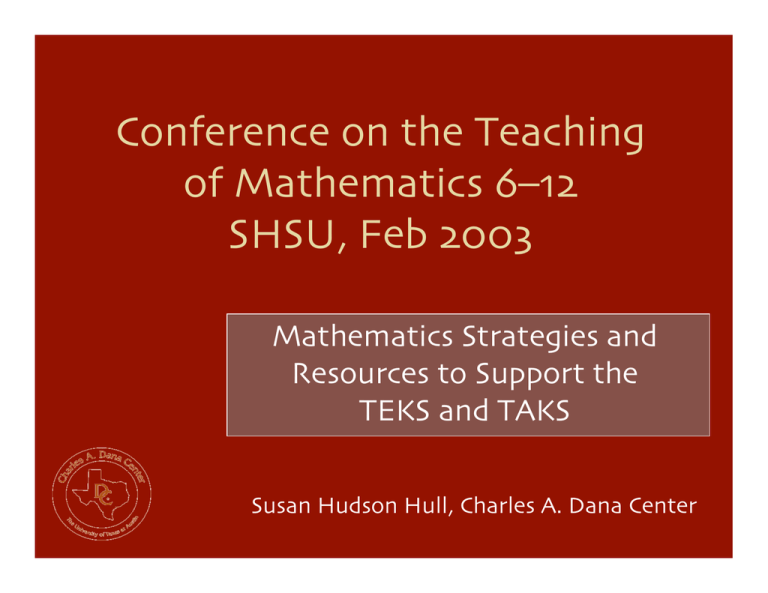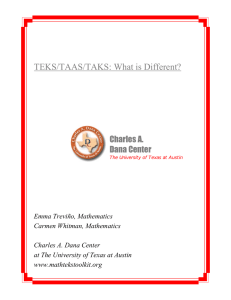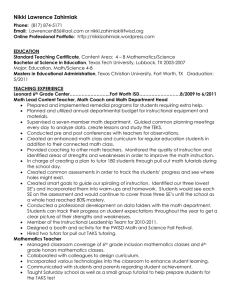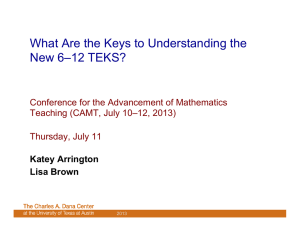Conference on the Teaching of Mathematics 6–12 SHSU, Feb 2003 Mathematics Strategies and
advertisement

Conference on the Teaching of Mathematics 6–12 SHSU, Feb 2003 Mathematics Strategies and Resources to Support the TEKS and TAKS Susan Hudson Hull, Charles A. Dana Center Charles A. Dana Center, UT Austin Mathematics Center for Educator Development • Resources for mathematics and science teachers • Resources for administrators • Resources for districts We are hearing a lot in No Child Le) Behind about using research-based decision making, scientific-based research, and evidence-based research. What does this mean … At the national level? At the state level? What does it mean to learn mathematics successfully? Mathematical proficiency: interwoven strands developed together; emphasizing no strand over the others • Understanding (conceptual understanding) • Computing (procedural fluency) • Applying (strategic competence) • Reasoning (adaptive reasoning) • Engaging (productive disposition) - Adding It Up, NRC, 2001 What does research suggest? • Opportunity to learn is considered the single most important predictor of student success. • Students learn best when presented with academically challenging work focused on sensemaking, problem solving, and skill building. • Teacher beliefs about what students need to (and can) learn influence their instructional decisions. • The same teaching and learning principles apply to all students, including those with special needs. - Adding It Up, NRC, 2001 What does research suggest for improving Algebra I? Factors for improving scores: • sense of urgency and priority • expectations for all students • expectations for all teachers • effective professional development • appropriate resources and materials, such as graphing calculators. - Improving Algebra I End-of-Course Exam Scores: Evidence from the Field, Charles A. Dana Center, 2000 How is Texas responding to No Child Le) Behind? written curriculum The Instructional Program in Texas pre-2002 instruction assessment The Instructional Program in Texas 2002 and beyond TEKS TEKS TAKS Taught Goal: Student Learning/ Student Achievement Teaching TEKS Teaching TAKS Mathematics Strategies to Support TEKS and TAKS Why are we concerned about the TAKS? • Grades 3-8 • Grade 5 & 8 assessment (SSI in 2005) • High school content assessment Grades 9-11 (Algebra I, Geometry, and some TEKS from grade 8) • Accountability Mathematics Strategies to Support TEKS and TAKS Teach the TEKS Teach the TEKS Teach the TEKS It’s not about TAKS, it’s about TEKS! We have TAKS to assess TEKS understanding. But we hear a lot about other assessments: diagnostics, benchmarks, etc. Help! The Assessment Principle Assessment should • support the learning of important mathematics • furnish useful information to both teachers and students • be a valuable tool for making instructional decisions • be a routine part of the ongoing classroom activity rather than an interruption Principles and Standards for School Mathematics, NCTM, 2000, p. 22 Where and when to assess … Assessment Tools Timing Diagnostic assessments, state or district Beginning of school year Performance assessments Ongoing; teachers continually monitor student progress Benchmark assessments, campus or district According to campus/district schedule (TAKS) Texas Assessment of Academic Skills End of school year, dates set by state Resources for Mathematics TEKS Support available through the Math CED/Dana Center Performance Assessments Mathematics Standards in the Classroom, Grades 3-5 and 6-8 (print, CD, web) Algebra I Assessments (print, CD, web) Geometry Assessments (print, CD, web) Algebra II Assessments (coming 02-03) Middle School Proportionality Assessments (coming 02-03) But assessments are just one piece. What about instruction? How do we put this all together? What resources are available? TEXTEAMS Mathematics Institutes Statewide K-12 professional development with an emphasis on … • Improving mathematical content knowledge of teachers • In-depth attention to the TEKS • Connections to classrooms and instructional practice Developed by the Dana Center; funded by TEA. Mathematics TEXTEAMS Institutes Middle School Rethinking Middle School Mathematics series: -Proportionality Across the TEKS -Algebraic Reasoning Across the TEKS -Numerical Reasoning Across the TEKS -Geometry Across the TEKS (new) -Statistical Reasoning Across the TEKS (6-12) (new) -Problem-solving (summer 2003) Practice-based Professional Development: -Middle School Prop0rtionality Assessments (summer 2003) Mathematics TEXTEAMS Institutes High School • • • • Algebra I: 2000 and Beyond Geometry: Supporting TEKS and TAKS (new) Algebra II/Precalculus (separate institutes 02-03) Rethinking Secondary Mathematics series: -Algebraic and Geometric Modeling -In-depth Secondary Mathematics -Statistics Across the TEKS (new) Practice-based Professional Development: Algebra I Assessments (new) Geometry Assessments (new) Algebra II Assessments (2002-03) Resources for Mathematics TEKS Support available through the Math CED/Dana Center Math TEKS booklets (print, web) Math TEKS/TAAS/TAKS charts (print, web) TEKS Trails (Algebra, Geometry, 3-5, 6-8) K-12 TEKS → success for all in AP Calculus (chart and pd) Foundations for Functions (for vertical teams) Charts, posters (print) & other resources Mathematics TEKS Toolkit www.mathtekstoolkit.org Contact information: Susan Hudson Hull Mathematics Director, Charles A. Dana Center (512) 471-6190 shhull@mail.utexas.edu Presentation available under Resources: www.mathtekstoolkit.org Reference List •Charles A. Dana Center. (2000). Improving Algebra I End-of-Course Exam scores: Evidence from the field. Austin,TX: Author. •Kilpatrick, J., Swafford, J., & Findell, B. (Eds.). (2001). Adding it up: Helping children learn mathematics. Washington, DC: National Academy Press, National Research Council, Mathematics Learning Study Committee. •Kilpatrick, J., Swafford, J., & Findell, B. (Eds.). (2002). Helping children learn mathematics. Washington, DC: National Academy Press, National Research Council, Mathematics Learning Study Committee.




